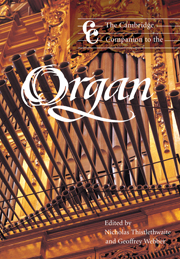Book contents
- Frontmatter
- Part I The instrument
- Part II The player
- Part III Selected repertoires
- 10 Italian organ music to Frescobaldi
- 11 Iberian organ music before 1700
- 12 The French classical organ school
- 13 English organ music to c1700
- 14 Catholic Germany and Austria 1648–c1800
- 15 The north German organ school
- 16 The organ music of J. S. Bach
- 17 German organ music after 1800
- 18 French and Belgian organ music after 1800
- 19 British organ music after 1800
- 20 North American organ music after 1800
- Appendix: The modes (toni) and their attributes according to Zarlino
- Notes
- Bibliography
- Index
15 - The north German organ school
from Part III - Selected repertoires
Published online by Cambridge University Press: 28 September 2011
- Frontmatter
- Part I The instrument
- Part II The player
- Part III Selected repertoires
- 10 Italian organ music to Frescobaldi
- 11 Iberian organ music before 1700
- 12 The French classical organ school
- 13 English organ music to c1700
- 14 Catholic Germany and Austria 1648–c1800
- 15 The north German organ school
- 16 The organ music of J. S. Bach
- 17 German organ music after 1800
- 18 French and Belgian organ music after 1800
- 19 British organ music after 1800
- 20 North American organ music after 1800
- Appendix: The modes (toni) and their attributes according to Zarlino
- Notes
- Bibliography
- Index
Summary
When J. S. Bach applied for the post of organist at the Jakobikirche in Hamburg in 1720 he had hoped to inherit one of the most famous organs in north Germany (see Figure 15.1). Like many of the finest organs of the period it was an instrument that had been enlarged several times over, most recently by the most famous of all north German builders, Arp Schnitger. Earlier builders including members of the Scherer family had contributed to the fifty-three-stop instrument of three manuals and pedals recorded by Michael Praetorius (Praetorius 1619/1985: 168), and in 1635 Gottfried Fritzsche had added a fourth manual and new Rückpositiv. Schnitger, who had just completed an enormous instrument for the nearby Nikolaikirche (four manuals, with sixty-seven stops including a 32′ Posaune as well as a 32′ Principal for the case), completely replaced all the workings of the organ, keeping most of the flue pipework but adding a new set of fourteen reed stops. Bach made no secret of his admiration for the north German organs he encountered, and had the greatest respect for particular celebrated combinations of player and instrument, notably Johann Reincken at the Katharinenkirche in Hamburg, Georg Böhm at the Johanniskirche in Lüneburg, and Dieterich Buxtehude at the Marienkirche in Lübeck.
Recently it has once again become possible to experience something of the overwhelming power and beauty of one of these large north German instruments that Bach knew. The organ at the Jakobikirche in Hamburg survived the Second World War by being temporarily dismantled, and in 1993, exactly 300 years after Schnitger finished his work on the instrument, Jürgen Ahrend rebuilt the organ in its Schnitger form, having already benefited from the experience of restoring other notable Schnitger instruments in the Netherlands and Germany.
- Type
- Chapter
- Information
- The Cambridge Companion to the Organ , pp. 219 - 235Publisher: Cambridge University PressPrint publication year: 1999



